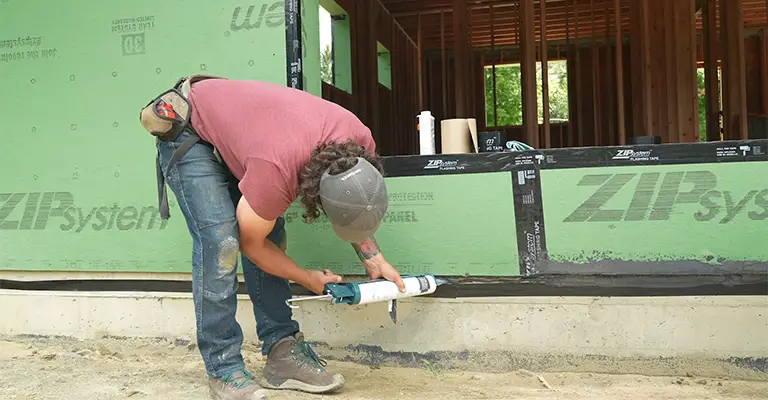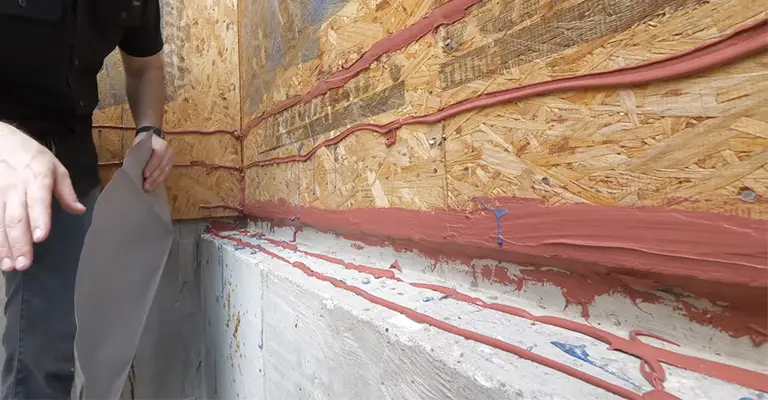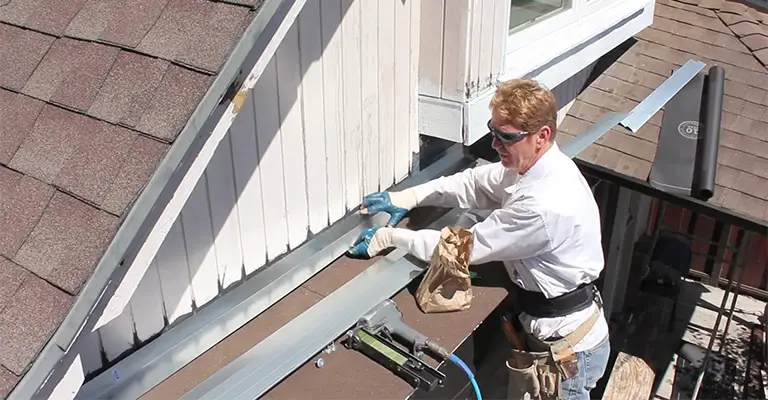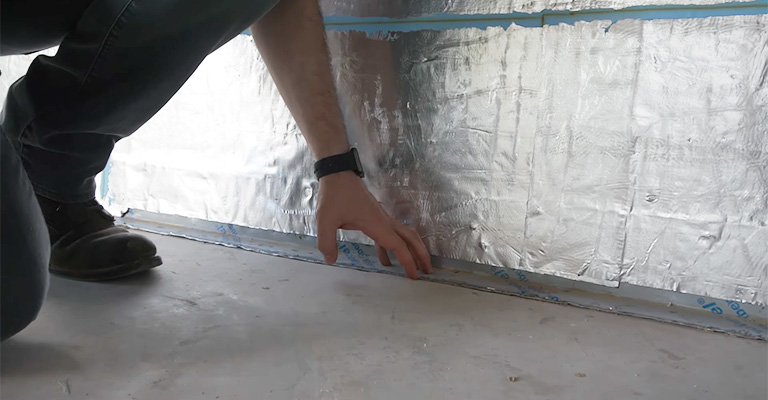When your house siding meets the concrete foundation, you might notice a piece of metal or vinyl called flashing. Flashing serves an essential role in preventing water from seeping into your home.
It is a thin piece of metal (usually) used to create a water-resistant barrier on the exterior of a building.
Flashing is a crucial component in construction that helps prevent water penetration and moisture damage at vulnerable points in a building, such as where siding meets concrete.
When installing flashing in construction, it will be used where two different materials meet, such as siding and concrete.
I am talking about installing some flashing and making that mundane intersection of materials look nice. In addition to making your home look attractive, it will also protect your siding from moisture damage.
What To Do About Where Siding Meets Concrete?
Snap a chalk line up about 8″ or so and run a Skilsaw down that line to cut off the siding. On the inside, put 2×4 blocking horizontally between the studs and behind the cut edge of the siding, and fasten that stopping to the framing.
Detect the cut edge of the siding and slip a Z-flashing under it… Paint the siding with a gap about 1/2″ from the siding edge and flashing. Reseal the siding to the studs and the new blocking (if necessary).
A L-shaped flashing should be installed where concrete meets the building. Afterwards, apply a bead of sealant to the concrete and embed the flashing in it, then fasten it to the framing. Next, install a PVC 1×8 under the Z-flashing over the flashing.
What is Flashing and Why is It Needed?
Installing flashing helps direct water away from vulnerable areas by providing an impervious surface. Flashing can inhibit water damage and mold growth when properly installed.
When siding meets the foundation, it is one of the most vulnerable areas in a home. As a result of its exposure to the elements and lack of adequate drains, this area is particularly prone to water damage.
Water that may come into contact with the siding must be redirected with the aid of flashing.
Why Is Flash Setting Important In Cement Setting?

For cement to set, flashing is essential. Doing so prevents water from seeping into the cracks in the concrete and siding.
In most cases, metal is used for flashing, but many other materials can be used too.
Metal flashing is available in many thicknesses and widths and can be cut and shaped as necessary. An anticorrosion fastener must be used to attach metal flashing to the siding when installing metal flashing.
Unlike wood siding, metal flashing should not be installed over the top. In the long run, metal will corrode when it comes into contact with moisture.
Wood siding must be protected with tar paper or another type of moisture barrier to install metal flashing.
Flashing Where Siding Meets Concrete – How It Is Done

Where your siding meets concrete, you can flash in a few ways.
1. Choosing Appropriate Flashing
If a flashing is used for siding, it should usually be made of metal. You can easily bend the edge of the strip to ensure that it closes the seal correctly when using metals that balance durability and flexibility.
In some stores, you may be able to find flashing tape. You shouldn’t use it for siding in your home, as it may lose some durability with time. If the gap is close to the ground, you should seal it immediately.
Whenever you’re unsure, consult with a professional. You might be able to find some specialized options that work well for your situation.
2. Preparing The Area
Before a flashing event begins, ensure that the area around the flash is free of obstacles. The flashing area must be cleared of rocks, trees, parked cars, and tamped down.
It is essential to avoid cracking your old asbestos tiles by accident. After the concrete has been prepared, it must be able to handle the heat and sparks from the flash. Put a layer of system flashing tape over the concrete before applying a sealant.
3. Installing The Flashing
First, let’s examine the corners. These strips will serve as guides for the subsequent ones. In addition, starting at the corners can help address minor issues caused by flashing protruding just a few degrees past them.
Make sure you spread caulk sealant generously. After you’ve applied it evenly, check for gaps and make sure nothing’s left behind.
When waiting for your coat to cure, plan ahead to minimize any downtime. Self-leveling compounds have some alternative options.
Using a sealant, apply another layer of sealant over your entire setup after installing all the siding.
A simple application of this may help seal off any gaps that are too small for the naked eye to detect. According to its drying time, you may need to wait about an hour between every sealant application.
4. Decorating The Area
Only touch-ups should be done once the flashing has been sealed completely. If you don’t allow the sealant to properly cure, some paints may react unpredictably with it.
Moreover, excessive use may make the edges bumpy, which may require additional sealant.
You will have to do additional work to reach a beautiful surface if you use a lot of sealant on your countertop.
What Is Flashing At the Bottom Of Siding Called?

As its name implies, flashing is a thin piece of material (usually metal) used to repel water.
As a construction material, flashing is usually installed at the interface between two materials, such as siding and concrete foundations.
Using flashing prevents water from entering cracks and gaps between the materials. It’s especially important to do this in areas with a lot of rainfall or snowfall, as moisture can cause serious problems.
Generally, flashing is attached along the bottom of the sidings. If unsure, look for a thin metal strip running along the bottom.
You may want to consider installing some flashing if you cannot find evidence of it in your home.
How Do You Attach Flashing To A Masonry Wall?
In most cases, masonry nails or screws are preferred to attach flashing to masonry walls.
Firstly, drill pilot holes into the masonry at the correct intervals, then drive the nails or screws in until they’re flush with the surface.
It is also possible to use adhesive-backed flashing, which can be attached directly to the masonry with a construction-grade adhesive. For leak prevention, ensure that all joints are sealed with silicone caulk, regardless of how you do it.
Can You Pour Concrete Next To Siding?
Pouring concrete next to the siding is not recommended because it can damage the siding and cause cracks or other issues. Using a moisture barrier and other precautions will help you protect the siding if you pour concrete next to it.
Can You Attach Flashing To Concrete?
When you install siding on your home, it is essential to protect the concrete area where the siding meets. Flashing is used to prevent water from getting behind the siding and damaging it.
Clean the concrete area where the flashing will be installed before attaching it to it. In the next step, apply a caulking bead around the area’s perimeter. Afterwards, caulk around the edges and press the flashing in place.
Who Is Responsible For Flash Set In Cement?
Depending on the situation, the answer to this question may vary. Typically, the builder or contractor ensures the flashing is installed correctly on a new home.
If the flashing is already in place, then it is the responsibility of the homeowner to repair or replace it if needed.
Final Words
There isn’t a lot of difficulty installing flashing and ensuring it is adequately sealed. Most of the work involves liberal applications of sealant and ensuring there are no gaps at any stage.








